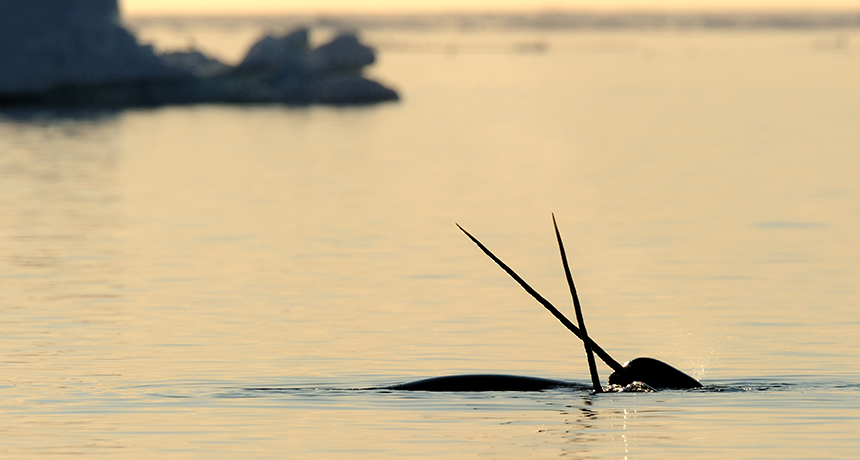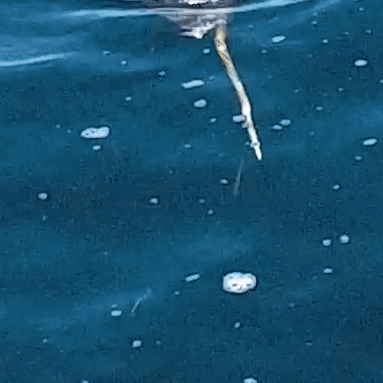Beware the tap of the narwhal’s tusk
A new video shows narwhals tapping prey fish with their tusks, maybe to stun them

The purpose of the narwhal’s mysterious tusk has been the subject of much scientific speculation. Now new video shows that the animals may use the elongated tooth to stun fish.
World Wildlife Fund
A surprising new video shows narwhals tapping fish with their unicorn-like tusks before chowing down on their catch. The video marks the first time scientists have ever seen such behavior.
“The narwhals were using the tip of their tusks to give a little tap to the fish,” says Marianne Marcoux. “The fish stopped moving for a few seconds, and then [the narwhals] ate them.” Marcoux is a marine biologist at the Department of Fisheries and Oceans Canada in Winnipeg, Manitoba. She’s an expert in narwhals. These whales are sometimes called the “unicorns of the sea” because of their single long tusks. Marcoux is the lead scientist on the team that captured the video.
The tusks are actually teeth. All adult narwhals have two teeth. Narwhals don’t use their teeth for biting or chewing. Instead, they suck their prey down whole. In the females, both teeth usually remain in the skull. In males, however, the left tooth grows out of the skull to become a tusk. It points straight up and can be as long as 3 meters (9 feet). The right tooth stays embedded in the skull.
Exactly how narwhals use their tusks is a bit of a mystery. One early idea about the tusks was that males used them to fight each other. But no one has ever reported seeing that happen. Most researchers now believe the animals don’t use their tusks this way.
Marcoux and her team captured the new video in August 2016. It was during a research trip to Tremblay Sound, a fjord on the north coast of Baffin Island in the Canadian Arctic. A World Wildlife Fund filmmaker attached a video camera to a drone and flew it over the water where narwhals were swimming. The drone filmed from between 15 and 30 meters (50 to 100 feet) above the water’s surface.
In the video, the narwhals are tracking Arctic cod with their tusks. It’s hard to see in the video, but sometimes the narwhals tap fish with their tusks before eating them. Sometimes the narwhals just eat the fish without tapping. In both cases, the fish stop moving and appear stunned.
Story continues below video.
World Wildlife Fund
Tap attack
“It’s clear the whales are immobilizing fish before eating them,” says Martin Nweeia, who watched the video. “It’s less clear the striking of the tusk is involved in immobilizing them.” Nweeia has been studying narwhal tusks for nearly 20 years. He works at Harvard University in Boston, Mass., and has worked in the past with the team that recorded the video.
Nweeia suspects the narwhals aren’t smacking fish unconscious with their tusks but are using sound waves to stun them.
During a research trip a few years ago, he captured sound coming from a narwhal. While he ran his recording equipment, he stood beside the whale in shallow water while it was restrained in a net. “For a brief second, my right leg went numb,” he says.
In the past, some researchers have proposed that whales may be able to stun prey using sound. But experiments have not backed that up.

So if narwhals were somehow able to stun their prey with sound, why would some tap the fish with their tusks? Maybe the narwhals were simply playing with their food, Nweeia says. “It’s possible the whales are just having fun.”
In 2014, Nweeia published research showing that narwhal tusks are very unusual teeth. Unlike most mammal teeth, including ours, they have no enamel coating. Tooth enamel is a thin layer of minerals that protects the nerves underneath.
Without the enamel, the nerves in the narwhals’ tusks can better sense changes in the water. Nweeia thinks these nerves help the whale track how salty the water is.
This is important because it tells the whales when ice is forming in the area. Ice is made of fresh water — water that is not salty. When ice forms in the ocean, it takes up only the water, leaving behind the salt. This makes the surrounding water slightly saltier. The increasing salt content is a signal for narwhals to leave the area, Nweeia says. “If there is ice over their heads, they can’t breathe.”
The puzzle of how narwhals use their tusks is still incomplete, but the video adds one more piece. Marcoux and her team are writing a paper about the newly discovered behavior. They hope to publish their research soon, including possible explanations for the tusk tapping.
There are about 177,000 narwhals in the world, says Marcoux. About 80 percent of them live in Arctic waters around Canada. They are a species of “special concern,” which means they could become endangered if their environment changes. In the Arctic, climate change is significantly boosting temperatures, melting the ice in the area. No one yet knows how this might affect narwhals.
“We don’t know much about narwhals. Every little discovery is important,” says Marcoux. “It helps us to know them better and protect their environment.”







